|
.
"During the reign of Napoleon ... France reached the height of its power.
By 1807, after spectacular triumphs at Austerlitz, Jena and Friedland,
many Europeans believed the French were invincible.
The French Empire was eventually defeated, but memories
about the Napoleonic Wars lingered. Until World War I,
commanders and nations throughout the world hoped to
reproduce Napoleon's lightning campaigns."
- www.wikipedia.org 2005
|

The Imperial French Army.
1800 - 1815
 On picture: charging Napoleonic hussar. Maughan - "Napoleon's Cavalry Recreated in Color Photographs".
On picture: charging Napoleonic hussar. Maughan - "Napoleon's Cavalry Recreated in Color Photographs".
France had been aggressive neighbor, and other nations (especially Austria and England), were willing enough to see her weakened. The European powers formed alliance and France was forced
to dramatically strengthen her army. Conscription was the solution.
Generally speaking, under the empire 100.000 conscripts were called annually, which meant that about 1 name in 7 was drawn. The last conscripts to join their units en masse were those of 1814, whose call-up had been advanced to the preceding year.
(Barbero - "The Battle" p 20, 26) Conscription allowed the French to form the Grande Armee, what Napoleon called "the nation in arms", which successfully battled European professional armies.
Under Napoleon many new regiments were formed, the discipline and morale greatly improved. All the troopers were dressed, fed, armed to teeth and very eager to fight.
In 1805 the French army was the largest and the most powerful in Europe and in the World.
The Napoleonic period (1805-1813) saw France's influence and power reach immense heights.
But gone were the republican days "when any officer under the rank of major had had to hoof it with his men. For the top brass alone the famous Parisian coachbuilder Gros-Jean has built no fewer than 300 carriages ... Colonel Count Francois Roguet of the 1st Grenadiers ... has brought with him 6 servants, 12 horses and two wagons filled with his personal effects, among them books and a great many maps." (Austin - "1812: The March on Moscow" p 49)

The Glory Years 1803-1807.
Ulm, Austerlitz, Jena and Friedland
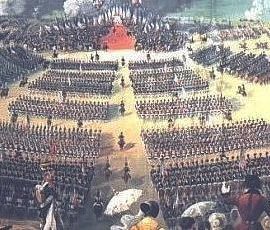 On picture: Grand parade at Boulogne Camp.
On picture: Grand parade at Boulogne Camp.
During the early period of Empire (1803-1807) Napoleon's army reached its peak.
According to reseracher Robert Goetz following the breakdown of the Peace of Amiens Napoleon took the opportunity to assemble an Army of the Ocean Coasts along the English Channel in preparation for an invasion of Great Britain. Approx. 100,000-150,00 troops (of total 450,000) gathered in training camps for 18 months and went through intensive training and maneuvers on large scale.
(The remaining 300,000 were spread along the long borders, busy with occupying Hanover, Italy etc. They were also good soldiers, they fought in some small engagements like Maida etc. but they were not equal to those of Boulogne Camps under the Emperor himself.)
'Even though a large part of the troops there were veterans, they began with a month of "refresher" training in the schools of the soldier and of the company. Then came 2 days of battalion and 3 days of division drill every week; on Sunday the entire corps drilled - infantry, cavalry, and artillery together. That training well absorbed, there were large-scale maneuvers twice a month. (In contrast the Austrians, Brits, Russians and Prussians did it only few times a year) There was also much target practice; artillerymen were sometimes able to use British warships as moving targets. Davout added practice in night fighting and firing. (Elting - "Swords Around a Throne" p 534)
Napoleon also cleaned out the 'deadwood from among his officers', approx. 170 generals (too old, or simply incompetent) were retired. It left him with such talented generals like Massena, Davout, Lannes, St. Cyr or Suchet.
Boulogne, map (ext.link)
Napoleon at Boulogne Camp, picture (ext.link)
Boulogne Camp, photo of French and Polish reenactors (ext.link)
The troops from Boulogne Camps and those occupying Hannover were put together and formed a new army that would soon become legendary - the Grand Army (Grande Armee). These troops had had close to 3 years of training and drill. Approx. 1/3 were veterans of at least 6 years' service. According to de Segur the old-timers could easily be recognized "by their martial air. Nothing could shake them. They had no other memories, no other future, except warfare. They never spoke of anything else. Their officers were either worthy of them or became it. For to exert one's rank over such men one had to be able to show them one's wounds and cite oneself as an example." They stimulated the new recruits with their warlike tales, so that the conscripts brightened up. By so often exaggerating their own feats of arms, the veterans obliged themselves to authenticate by their conduct what they've led others to believe of them.
The Grand Army demolished the armies of the established great powers of Europe.
They won with easy in such epic battles like
Ulm,
Austerliz,
Jena, Auerstadt and
Friedland. (ext.links)
(After Austerlitz, Tsar of Russia Alexander was extremely
depressed. He dismounted "and sat on the damp ground beneath a tree, where he covered his
face with a cloth and burst into tears." Source: Duffy - 'Austerlitz')
1805 & 1806
Easy victories
The soldiers of Boulogne Camps outmarched and outfought every opponent.
In November at Mariazell 4 battalions of these warriors routed 8 Austrian battalions. The French took large numbers of prisoners. General Friant wrote that at Austerlitz "No sooner had the 15e Legere and 33e Ligne arrived and deployed than they marched on the enemy, nothing could resist their attack, the 15e was directed at the bridge and chased a corps 10 times more numerous than they, penetrated Sokolnitz, intermingled with the Russians, slaughtering with the bayonet all that dared oppose them."
General Thiebault described how the infantry manoeuvered at the Battle of Austerlitz (on the Goldbach Heights): "The two corps [of Lannes and Soult] executed their rearward movement in squares, chequer-wise... For my own part I was no less struck by the novelty than by the magnificence of the spectacle. Nothing could be finer or more imposing than the 30 moving masses, which after two hours' march extended over a distance of five miles, while their arms sparkled in the sun." The Russians and Austrians noted that the French regiments maneuvered calmly and with precision "as if on parade ground."
The musket fire of French infantry was very effective due to the considerable musketry practice with live ammunition that the French had received at Boulogne Camps.
According to Robert Goetz "the French infantry was indisputably the finest in Europe in 1805, and perhaps even the finest infantry fielded throughout the wars of 1792-1815." (Goetz - "1805: Austerlitz" p 45) Austrian General Stutterheim wrote: "The French infanatry manoeuvered with coolness and precision, fought with courage, and executed its bold movements with admirable concert."
This is not surprising that Napoleon was very proud of his army. In 1805 after the victory at Austerlitz he wrote: "Soldiers ! I am pleased with you. On the day of Austerlitz you have justified what I had expected of your intrepidity. You have decorated your Eagles with an immortal glory ...in two months the Third Coalition is conquered and dissolved."
In 1806 the campaign against Prussia was a brilliant one. The enemy was outmaneuvered and defeated at jena and Auerstadt. The Prussian forces were scatterred all across Prussia and the remainder of the campaign was basically a mopping-up operation.
Battle of Austerlitz, large map. (ext.link)
Napoleon at Austerlitz, picture. (ext.link)
Napoleon at Austerlitz, postcard. (ext.link)
Battle of Jena, map. (ext.link)
Battle of Jena, picture. (ext.link)
Infantry at Jena, picture. (ext.link)
Battle of Friedland, map. (ext.link)
French artillery at Friedland, picture. (ext.link)
1806-1807
Harsh winter
Bloodbath at Eylau
In the following years there was not enough peace-time to train the troops to the same high level. Already the winter campaign of 1806-1807 in eastern Prussia and Poland exhausted the French troops mentally and physically.
Napoleonic troops became known for swift movements and rapid marches, but in 1806 in Eastren Prussia (wooded area and with few inhabitants, virtually wilderness) and in Poland the thick mud and abysmal roads made it impossible. It was with extreme difficulty that the artillery could be moved along.
The battles of Eylau and Heilsberg were a very bloody and inconclusive contest between the French and a mostly Russian army under Benigssen.
At Heilsberg the French lost 12,000 killed and wounded. At Eylau they have suffered 15,000-25,000 killed and wounded, this is about 1/3 of their forces. Riding over the battlefield one of the French commanders said: "Quel massacre ! Et sans resultat" (What a massacre! And for no outcome.) The French soldiers cried out for peace after Eylau.
Eylau was the first serious check to the French Grand Armee, which in the previous two campaigning seasons had carried all before it.
In spring 1807 though the weather was still severe, so Napoleon rousted his troops out of their winter quarters for drills and frequent field exercises. The army was weakened as many veterans were killed, wounded or sick and in hospitals. Meanwhile in France thousands of young men were called to arms. Napoleon caused these to be despatched to the front as soon as possible and they were drilled en route.
Napoleon at Eylau, large picture by Gros (ext.link)
Murat and his 10,000 cavalrymen at Eylau, picture. (ext.link)
French Guard cavalry at Eylau, picture. (ext.link)
Infantry combat at Eylau, picture. (ext.link)
French cavalry vs Russian infantry at Eylau, picture by Flameng. (ext.link)

1808-1811.
"After 1808 fewer French soldiers
received extensive training."
- Colonel J. Elting
 On picture: French light cavalrymen captured British infantryman, by Woodville.
On picture: French light cavalrymen captured British infantryman, by Woodville.
In this period the army was still in good shape, although not as good as few years ago.
Much of the revolutionary ardour that had fired the French troops of the 1790s and early 1800s had been quenched by 1808. Napoleon himself sensed a lack of enthusiiasm for the forthcoming campaigns.
In 1808-09, for the new war with Austria tens of thousands of new recruits joined the field armies. They were hastily trained. "After 1808 fewer French soldiers received extensive training." (Elting - "Swords Around a Throne" p 534)
Napoleon increased their effectiveness in the field and bolstered their morale by forming regimental artillery and attaching 2-3 light guns to every infantry regiment.
The influx of conscprits diluted the old ideals of austerity, self-respect and duty. After 1809 drunkenness and indiscipline increased, especially in the cavalry. Among the French troops occupying Spain looting was rampant, discipline was poor. The veterans were demoralized by plunder and waste and by the cruel war with Spanish guerillas. They had got out of the habit of being inspected. Training had fallen off during the years.
The first provisional regiments, squadrons and battalions appeared already in October 1807.
Napoleon, when he needed, took one or two squadrons/battalions from one regiment and
one or two from another regiment, named a field officer and thereby formed a provisional
regiment. Rarely these troops returned to their parent regiments. The temporary regiments
had no Colors, no Eagles, no esprit de corps and no tradition. They served mainly in Peninsula against the Spaniards and the British.
Between 1808 and 1811 the French enjoyed several victories, including the costly victory at Wagram (ext.link) where Napoleon suffered more than 30,000 killed and wounded (!) Austria was again brought on her knees. The war in Spain was not a bloody affair, there were few battles and apart, but the troops were demoralized by lack of discipline, looting, and fighting the elusive Spanish guerillas and British troops.
Several hundred of veterans were selected from the troops in Spain and sent to join the Middle Guard. Although they looked good with tanned faces, some of them went around and stole things in Paris. General Michel arrested them and sent to prisons.
John Arnold wrote on French failure in Peninsula: "A young French conscript, Phillipe Gille, provides a detailed account of the inadequate manner in which French soldiers were rushed to the front. Mobilized in France in 1808, Gille apparently did not even receive his musket until arriving at the Spanish border.
There he joined a provisional unit composed of fellow conscripts, crossed the border, and soon
engaged in combats with guerilla. Eventually his unit merged with similar ad-hoc formations to make up Dupont's ill-fated army.
Near the Spanish town of Jaen they faced their first formed opposition from Spanish regulars. In spite of their inexperience,
the conscripts formed line, advanced with trailed arms, received a close range volley, charged at the bayonet, and routed the
Spanish. While such intrepid shock action worked against poorly trained Spanish infantry, it was ill-suited for more
professional opponents such as the British. ...
During the Peninsula years, how large a numerical contribution to the French armed forces were conscripts such as Gille?
For the decisive years 1808 to 1812, French annual conscript calls ranged from 181,000 to 217,000. During 1810
and 1811, when France was at peace in the rest of Europe, the majority of these conscripts went to the Peninsula and
substantially diluted the quality of the French forces serving there.
Simultaneously, troop quality declined further as veterans suffered some of the nearly 100,000 casualties sustained in the Peninsula in 1810-1811. The impact of this dilution is
clearly stated by General Anne Savary. Savary's report on the 1809 Battle of Essling, where he fought with troops substantially
better than the average Peninsula soldier, observes, "if instead of troops consisting of war levies [raw conscripts], we had
opposed to them such soldiers as those of the camp of Boulogne [the Grande Armée], which we might easily have moved
in any direction and made to deploy under the enemy's fire without any danger their being thrown into disorder".
Innumerable Peninsular battlefields demonstrated this need....
 The problem worsened as the Peninsula became a secondary front. A typical Peninsula regiment of 2,500 men
would send 120 to 200 men back to France as a depot unit, 50 to the artillery, 10 to the gendarmes, and 12
of the best men to the Imperial Guard. These subtractions, coupled with the unprecedented guerilla-inflicted losses
experienced in the never secure rear areas, seriously eroded the staying power of the infantry regiment. It got worse
in 1811 and thereafter when Napoleon withdrew the best troops from the Peninsula to prepare for the Russian invasion."
(James Arnold - "A Reappraisal of Column Versus Line in the Peninsular War")
The problem worsened as the Peninsula became a secondary front. A typical Peninsula regiment of 2,500 men
would send 120 to 200 men back to France as a depot unit, 50 to the artillery, 10 to the gendarmes, and 12
of the best men to the Imperial Guard. These subtractions, coupled with the unprecedented guerilla-inflicted losses
experienced in the never secure rear areas, seriously eroded the staying power of the infantry regiment. It got worse
in 1811 and thereafter when Napoleon withdrew the best troops from the Peninsula to prepare for the Russian invasion."
(James Arnold - "A Reappraisal of Column Versus Line in the Peninsular War")
.
"The very morning after our arrival,
we were uniformed and armed, and,
giving us time to breathe, the NCOs
set about inculcating is us the
principles of our new trade.
They were in a hurry ..."
- Recruit of 17e Legere Regiment
|

1812.
Invasion of Russia.
Disastrous Retreat.
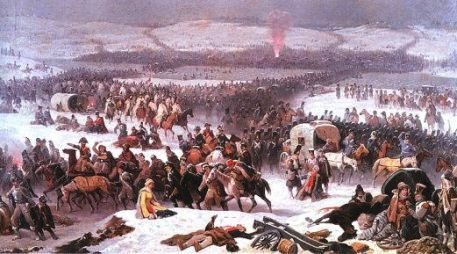 In 1811, except the guerilla war in Spain, Europe was in peace.
Napoleon had time to train the young soldiers. They were clothed and well armed.
The cavalry was supplied with thousands of German, Polish and French horses.
The artillery and engineers were well equipped and trained. The Grand Army of
1812 was almost as good as the Grand Army of 1805. But in 1812 there were less veterans
in the ranks but the troops were better suplied and armed (far more guns).
"The veteran troops were sadly diluted by the influx of recent recruits and the demands of the Spanish campaign.
A similar expansion had occurred in 1809 when the French army was largely composed of new recruits. In both instances the recruits lacked the discipline and savoir faire to
be able to sustain themselves in a foraging situation, but as the 1809 campaign was fought in Austria, the impact of this indiscipline on supplies was minimal compared to what it was to be in 1812."
(Nafziger - "Napoleon's Invasion of Russia" p 88)
In 1811, except the guerilla war in Spain, Europe was in peace.
Napoleon had time to train the young soldiers. They were clothed and well armed.
The cavalry was supplied with thousands of German, Polish and French horses.
The artillery and engineers were well equipped and trained. The Grand Army of
1812 was almost as good as the Grand Army of 1805. But in 1812 there were less veterans
in the ranks but the troops were better suplied and armed (far more guns).
"The veteran troops were sadly diluted by the influx of recent recruits and the demands of the Spanish campaign.
A similar expansion had occurred in 1809 when the French army was largely composed of new recruits. In both instances the recruits lacked the discipline and savoir faire to
be able to sustain themselves in a foraging situation, but as the 1809 campaign was fought in Austria, the impact of this indiscipline on supplies was minimal compared to what it was to be in 1812."
(Nafziger - "Napoleon's Invasion of Russia" p 88)
Before the campaign began General Dejean wrote to the Emperor that up to a third of the horses
in cavalry were too weak to carry their burden, while nearly half of the men were too
puny to wield a saber. Colonel Saint-Chamans wrote: "I was not happy with the way the
cavalry was being organised. Young recruits who had been sent from depots in France before
they had learnt to ride a horse or any of the duties of a horseman on the march or on campaign,
were mounted on arrival in Hanover on very fine horses which they were not capable of
managing." The result was that by the time they reached Berlin, the majority of the horses
were suffering from lameness or saddle sores induced by the riders' bad posture or their
failure to take care in saddling up. More than one officer noted that recruits were not
taught about checking whether their saddle was rubbing or how to detect the early signs of
saddle sores.
Napoleon however liked the big numbers of soldiers, even if they were young recruits mounted on weaker horses.
He wrote: "When I put 40,000 men on horseback I know very well that I cannot hope for that number of good horsemen, but I am playing on
the morale of the enemy, who learns through his spies, by rumour or through newspapers
that I have 40,000 cavalry... I am preceded by a psychological force..."
Most military experts agree that the Grand Army of 1812 was the most carefully and completely
organized force Napoleon had ever commanded. It had the most thoroughly prepared supply system (The baggage was hauled by
18,000 heavy draft horses). The army was also bigger than any other army Napoleon had
before. One of the conscripts wrote: "Oh Father !, this is some army ! Our old soldiers
say they never saw anything like it." But only half of the troops were French, the rest were
made up of Poles, Italians, Germans, Swiss, and Austrians. Napoleon passed the Imperial
Guard in review at Dresden, before a throng of vassal rulers, including many princes, five
kings and one emperor (of Austria).
William Napier writes: "... the 200,000 French soldiers arrived on the Niemen in company with 200,000 allies. ...
assembled by this wonderful man, all disciplined warriors, and notwithstanding their
different national feelings, all proud of the unmatched genius of their leader."
(Napier - "History of the War in the Peninsula" Vol III, p 447)
The problems.
In the beginning of the campaign there were not many stragglers and the discipline
was strict, at least in some units. Three or four days out of Vilna, von Roos saw:
"a division of cuirassiers formed up in square. In the middle four soldiers were digging
up the earth. We were told a court-martial had condemned them to death for flouting orders.
They were going to be shot; but first had to dig their own graves." Even for the officers
and generals it was a very difficult time. The food and quarters were very poor.
Britten-Austin writes: "... a general appears on horseback in the open doorway ... not
even bothering to dismount, he begins cursing and swearing and complaining that his
lodgings aren't worthy of a lieutenant-general attached to General Headquarters.
'I demand you instantly find me something else !' Polite as ever, the commandant
[governor] points out that, what with lodgings beeing needed for the Emperor and all the
staff, there is very little choice. "The man doesn't accept this sensible reply, but starts
insulting the governor ... Suddenly the tall man gets up from his writing table, pushes the
governor aside, and in a voice of thunder roars up at the raging general: 'If you are not
satisfied, you can f--k off ! D'you think we've nothing better to do than listen to your
f---ing complaints ?" The man on horseback only had to set eyes on the tall man to whip
off his hat, bend his back in equestrian bow, and stammer out an apology. But the tall man
just tells him to go to the devil and returns to his writing table.' Muraldt, who has
'watched this scene open-mouthed,' asks another officer who the tall man is.
It's Caulaincourt." (Britten-Austin - "1812 The March on Moscow" p 129)
Russia was a remote giant land with poor road system and once the campaign began there
were numerous problems with supplies.
"As supplies became scarce in 1812, discipline broke down and the control over the troops
diminished. They plundered indiscriminately instead of carefully requisitioning the supplies they found.
Surprisingly, the officers refused to take part in the excesses and often suffered to a greater degree than the men they led.
This lack of discipline forced the inhabitants of the region to flee and hide those supplies that might have assisted the French army."
(Nafziger - "Napoleon's Invasion of Russia" p 88, 1998)
The discipline of the troops decreased while the amount of stragglers and sick rapidly increased.
At Niemen River Davout's I Corps had 79,000, but at Smolensk only 60,000.
The situation in other troops was even worse. Ney's III Corps had 44,000 at Niemen and only 22,000 at Smolensk. Murat's Reserve Cavalry numbered 42,000 at Niemen and 18,000 at Smolensk.
Before the army reached Moscow it lost half of its strength.
At the battle of Borodino (ext.link) more than 30,000 were killed and wounded. It was THE bloodiest battle of Napoleonic wars. But hunger, Cossacks and weather decimated the troops more than the regular Russian army. After Napoleon left Moscow the situation changed from bad to worse.
The debris of the Grand Army which in June 1812 had crossed the Niemen River was now
chased back by Cossacks and armed peasants. The Russians captured thousands of POWs.
"I have no army any more!"
Many regiments ceased to exist. For example the 5th Regiment of Cuirassiers had 958
men present for duty on June 15th, 1812. On Feb 1st 1813 had only 19 !
The French cavalry never
recovered from the massive loss of horses. Nine out of ten cavalrymen who survived walked much of the way home; most of those who rode did so on tiny, but tough, Russian and Polish ponies, their boots scuffing the ground. (large picture, ext.link)
Napoleon wrote: "I have no army any more! For many days I have been marching in the midst
of a mob of disbanded, disorganized men, who wander all over the countryside in search of
food."
George Nafziger writes: ""Of the 680,500 men that Napoleon had organized for his invasion of Russia, barely 93,000 remained. The main army had suffered the harshest casualties and had dwindled from 450,000 to 25,000 men. The flanking and rearguard forces under Schwarzenberg, Reynier, MacDonald, and Augereau had returned with a total of 68,000 men, but many of these men had not ventured very far into Russia, and those of Schwarzenberg, Reynier, and MacDonald had not been as heavily engages as the main army.
"Records suggest that 370,000 French and allied soldiers died either from battle or other causes, while 200,000 were taken prisoner by the Russians. Of those taken prisoner, nearly half died in captivity.
"Napoleon had taken 176,850 horses with him into Russia, and barely any of them survived the campaign. The Russians reported burning the corpses of 123,382 horses as they cleaned up their countryside of the debris of war. So heavy were the horse losses that one of Napoleon's most serious handicaps in the 1813 campaign was his inability to reconstitute his once-powerful cavalry.
"Of the 1,800 cannon taken into Russia, the Russians reported capturing 929 of them, and only 250 were brought out. The remainder were lost or thrown into swamps and lakes so that they might not be captured. Though the loss of cannons was serious, the loss of horses was more devastating to Napoleon. France's arsenals and industrial facilities would soon replace the lost weaponry.
"Of the 66,345 men that had belonged to Davout's corps in June 1812, there remained only 2,281. The 50,000-man Imperial Guard had been reduced to 500 men under arms and a further 800 sick, of whom 200 would never return to arms. Similar casualties were suffered by the II, III, and IV Corps ..."
.
"Evidently, some of the new troops looked so bad
in drill while still at the training centers that the
populace referred to the army as the 'infants of the
Emperor' - April 1813, Savory to Berthier
|

1813
Campaign in Germany
 On picture: Napoleon, his staff and army, from movie 'War and Peace' by Bondarchuk
On picture: Napoleon, his staff and army, from movie 'War and Peace' by Bondarchuk
French military was in crisis and scrambling to raise men as quickly as possible.
Despite such horrendous losses suffered in 1812 Napoleon decided to continue his fight.
He turned to every possible resource at his disposal that could produce manpower, and do
this quickly. It required not only time and energy but also money. The expense of organizing
only the Guard amounted to 18,000,000 frans !
The new army was huge but the 18- and 19-years old soldiers lacked stamina and the rapid marches and hunger weakened them physically. The high stress (they were put into action without full training) exhausted many of them. They fell sick by hundreds, there were also deserters and stragglers. Special detachments were formed to catch the stragglers and find the weak and 'make them walk'. In Paris alone 320 soldiers of Young Guard were arrested for desertion and sent to prisons. During Emperor's journey from Dresden (ext.link), through Gorlitz to Bautzen, he saw the German roads and villages choked with thousands of stragglers. Napoleon was outraged and issued the following order: "Every soldier who deserts his flag betrays the first of his duties.
As a consequence, His Majesty orders: Article 1. Evry soldier who deserts his flag without legitimate cause will be subject to decimation. To this effect, as soon as 10 deserters are returned the generals commanding the army corps will have them draw lots, and have one shot." Bautzen. 6 Septeber 1813 Napoleon." (Bowden - "Napoleon's Grande Armee of 1813" p 160)
Digby-Smith writes: "The strength and physical stamina of the young conscripts, and consequently the quality of their regiments, left much to be desired; they could not march like the veterans, fell easy prey to sickness, and the standard of their training when they left the depots in the spring 1813 was frighteningly low. The ability of battalions to manoeuvre was poor, and many recruits could not even load their muskets. When the reinforcements drafts marched to the front, carts had to follow them to pick up the footsore and the exhausted." (Digby-Smith, - p 29)
"The levy, calling upon the adolescents of France one full year before they normally would have been eligible for military service clearly illustrates Napoleon's desperate need for numbers of troops. " (Bowden p 31)
The new units were thrown together quickly and their men had not had the necessary time to form the interpersonal bonds within their companies that gave them the morale strength necessary to wage war successfully. Despite these problems, the army's morale was generally high. Many of the young troops who stayed in the ranks, were filled with boundless confidence in their leader whom they loved with unflagging devotion. The few veterans had regained their faith in Napoleon. The artillery and engineers were as usual excellent. When led by Napoleon in person the young soldiers won every battle (Lutzen, Bautzen, Dresden etc.) Without Him they were routed at Kulm, Dennewitz and Katzbach. (ext.link)
.
Many of Napoleon's marshals were either weary
or downright prophets of doom. In the end
of campaign some defected to the Allies.
|

1814.
The Campaign of France.
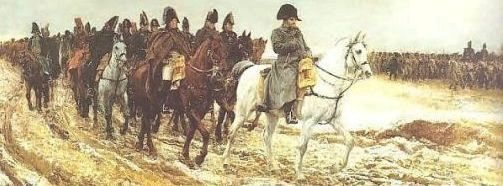 "A decree ordering a levy of 300,000 soldiers was made, and another augmenting the Guard to 112,500 men... The levy, however, was not successful. France was exhausted not only of her men, but even of her youth, and boys were now in his greatest need to form his battalions. To add to his trouble, as fortune always seems to delight in pushing down a falling favorite, the Typhus fever broke out among his troops along the Rhine." (Headley - "The Imperial Guard of Napoleon")
"A decree ordering a levy of 300,000 soldiers was made, and another augmenting the Guard to 112,500 men... The levy, however, was not successful. France was exhausted not only of her men, but even of her youth, and boys were now in his greatest need to form his battalions. To add to his trouble, as fortune always seems to delight in pushing down a falling favorite, the Typhus fever broke out among his troops along the Rhine." (Headley - "The Imperial Guard of Napoleon")
The recruits were poorly clothed and armed boys. A handful of heroes faced all of
Europe to whom they themselves had taught the art of fighting over the past decade.
Napoleon had mixed feelings about his troops in 1814. He wrote: "The Old Guard alone stood firm - the rest melted like snow." The lack of weapons and uniforms was one of the characteristics of the French troops during this war. Napoleon wrote that the peasants had picked up on the battlefields thousands of muskets abandoned by the enemy and that commissioners should be sent to collect them. In default of muskets there were 6.000 pikes manufactured.
By 1814 allied armies were advancing into France from every direction.
Napoleon put up an impressive performance, fighting on average a battle or skirmish every day, and winning many of them. The battles of this campaign included Brienne, Craonne, Laon, Montmirail and La Rothiere, Napoleon's first defeat on French soil.
Many of Napoleon's marshals were either weary or downright prophets of doom.
In the end of campaign some defected to the Allies. Paris was taken by storm by the Russian and Prussian troops.
.
"There was a prodigious gap between them (soldiers of 1815)
and our old soldiers from the Camp the Boulogne."
- Desales, officer of artillery of Erlon's I Corps
|

1815.
The Hundred Days Campaign.
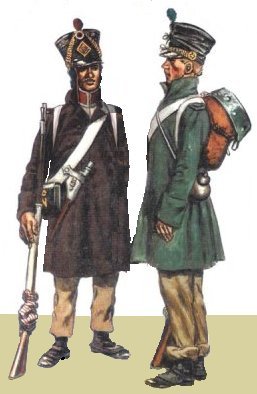 Some of the English authors claim that the French army of 1815 was made up of veterans and was Napoleon's best. The fact is the majority of the army that Napoleon rebuilt after returning from Elba, was composed of soldiers who had at least one campaign behind them, although in the eyes of veterans of Austerlitz and Egypt, the recruits of 1814 still seemed like little boys. (Barbero - "The Battle" p 20) A call for volunteers produced only some laughable 15,000 men.
There were French eyewitnesses who stated that many regiments included a high percentage of young soldiers who had never been under fire. Several battalions of Young Guard were in Vendee. General Lamarque complained that they were filled with recruits and deserters who neither knew how to maneuver nor shoot. (Lasserre - "Les Cent jours en Vendée: le général Lamarque et l'insurrection royaliste, d'après les papiers inédits du général Lamarque." published in 1906.)
Some of the English authors claim that the French army of 1815 was made up of veterans and was Napoleon's best. The fact is the majority of the army that Napoleon rebuilt after returning from Elba, was composed of soldiers who had at least one campaign behind them, although in the eyes of veterans of Austerlitz and Egypt, the recruits of 1814 still seemed like little boys. (Barbero - "The Battle" p 20) A call for volunteers produced only some laughable 15,000 men.
There were French eyewitnesses who stated that many regiments included a high percentage of young soldiers who had never been under fire. Several battalions of Young Guard were in Vendee. General Lamarque complained that they were filled with recruits and deserters who neither knew how to maneuver nor shoot. (Lasserre - "Les Cent jours en Vendée: le général Lamarque et l'insurrection royaliste, d'après les papiers inédits du général Lamarque." published in 1906.)
In 1815 Napoleon's army was not as good as their predecessors in 1804-1812 who felt invincible after the glorious victories at Austerlitz, Jena and Friedland.
The soldiers who marched to Waterloo knew well the taste of defeat, some survived the horrors of retreat from Russia, flights before Cossacks, defeats at Viazma, Berezina, Leipzig, Kulm, Dennewitz, La Rothiere and Paris. They also witnessed Allies' entry to Paris, capitulation and abdication of Napoleon. Thousands of ex-POWs who spent years in Russian, British or Spanish captivity now were accepted to the army. Some could be angry men but without the air of invincibility. According to Lachouque ("Anathomy of Glory") "notwithstanding the initial enthusiasm, not all the discharged veterans returned. Some had been spoiled by civil life."
Captain Duthilt thought the soldiers who had suffered the defeats of the emperor's recent campaigns and the returned prisoners of war from Russia had lost a great deal of their enthusiasm.
In 1815 the discipline was poor, the old timers were annoyed and complained that the young men went out with girls or got drunk. Sergeant Mauduit of Imperial Guard described his comrades during march toward Waterloo. The guardsmen had broken into houses and had stopped and plundered army supply wagons, laughing in the faces of the gendarmes assigned to maintain order along the road. General Radet, commander of the military police, was so disturbed by this behavior that he tendered his resignation that very evening.
The army was hastily assembled, lacked uniforms and shoes. At Ligny the Prussians took the poorly clothed Old Guard for second rate militia. (For comparison, eight years earlier at Friedland, the Guard entered battle in their parade outfits; including white gloves ! At Borodino, Guard's uniforms catched the eye of many troops around. Read memoirs of Heinrich von Brandt and you will know what I mean.
In 1815 not 20 men in the Guard could be found wearing the same uniform in any company in these regiments. The supplies were scarce and everything was performed in haste and confusion.
Many soldiers wore civilian clothes under their greatcoats and forage caps instead of shakos.
In some infantry regiments only the grenadiers were issued bayonets. Some cuirassiers had no armor. "The 11th Cuirassiers fought without them at Waterloo ... Shoes, twenty regiments had none." (Adkin - "The Waterloo Companion" p 24)
"For lack of shakos the 14th Light Regiment would fight the Waterloo campaign in fatigue caps." (Austin - "1815 the return of Napoleon" p 295)
In 1815 several French top rank commanders defected to the Allies.
On June 15 General Comte Louis Bourmount rode directly over to the Prussians and surrendered with five of his staff. According to Colonel Elting "Wellington should have been thoroughly informed as to Ney's strength, the chief-of-staff of one of d'Erlon's divisions having deserted to the English during the morning" (before the Battle of Quatre-Bras).
It all had a great impact on morale of the soldiers and junior officers. The old camaraderie of the troops was replaced by suspicion. "The soldiers were upset at the excessive number of senior officers who had betrayed, or who were suspected of being ready to betray the emperor... The troops had neither confidence in their commanders nor the ability to accept discipline." (Barbero - "The Battle" pp 277-278) At Waterloo an officer of horse carabiniers defected - in the middle of battle - to the British and Germans and informed the enemy about Napoleon's plans.
"The soldiers doubted the loyalty and competence of many senior officers.
They resented officers being promoted merely for going over to the Emperor while they
received nothing for doing the same. Six officers of the 1st Cuirassiers who had been rewarded in this way were greeted with groans and shouts on parade. The 12th Dragoons petitioned the Emperor requesting, "... the dismissal of our colonel, whose ardour in the cause of Your Majesty is by no means equal to our own." (Adkin - "The Waterloo Companion" p 78)
But not only officers and generals defected to the enemy. There were deserters even from the Old Guard. These traitors were ready to fight for King Louis and formed so-called "Bourbon Cavalry Corps". With them served deserters of cuirassier and dragoon regiments. This unit was under Wellington's command but not participated at Waterloo.
"Digby Smith is of the opinion that it's impossible to know the number of Guard survivors from Russia still present in its ranks in 1815, but points out that of the 400-600 officers and other ranks who'd
got back, many must have succumbed in Germany. The Grenadiers' and Chasseurs' composition in 1815 is perhaps relevant to the fiasco of the last fatal charge at Waterloo."
(Austin - "1815: the return of Napoleon" p 314)
At Waterloo a battalion of Old Guard was defeated by battalion of German militia, another battalion of Middle Guard was routed by Dutch infantry of Chasse's division. Two battalions were defeated by the British and Germans.

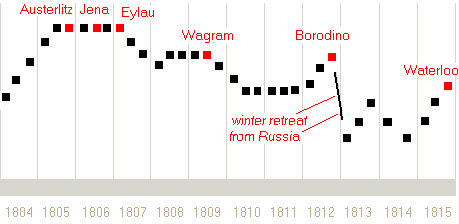
Quality of Napoleon's army.
|
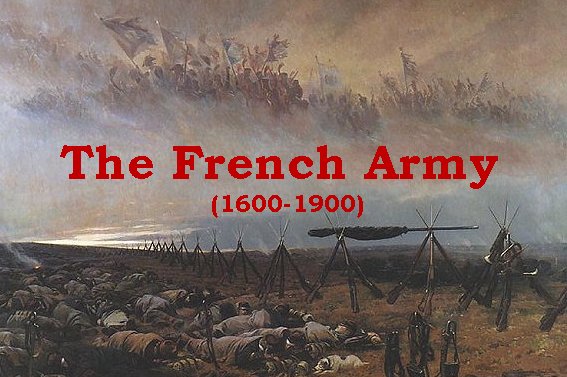

 On picture: Mousquetaires Noirs (Black Musketeers) in 1660
On picture: Mousquetaires Noirs (Black Musketeers) in 1660 Under King Louis XIV (
Under King Louis XIV (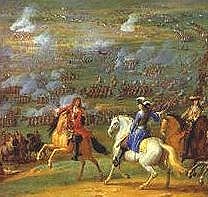 On picture: Battle of Rocroi 1643. It was the first major defeat
of a Spanish army in a century, although historians have noted that German, Walloon, and
Italian troops actually surrendered first, while the Spanish infantry cracked only after
repeated cavalry charges. The French carried out a huge cavalry encirclement, sweeping
behind the Spanish army and smashing their way through to attack the rear of the Spanish
cavalry that was still in combat with the reserves. The Battle of Rocroi put an end to
the supremacy of Spanish military doctrine and inaugurated a long period of French military
predominance.
On picture: Battle of Rocroi 1643. It was the first major defeat
of a Spanish army in a century, although historians have noted that German, Walloon, and
Italian troops actually surrendered first, while the Spanish infantry cracked only after
repeated cavalry charges. The French carried out a huge cavalry encirclement, sweeping
behind the Spanish army and smashing their way through to attack the rear of the Spanish
cavalry that was still in combat with the reserves. The Battle of Rocroi put an end to
the supremacy of Spanish military doctrine and inaugurated a long period of French military
predominance.

 Jean-Baptiste Donatien de Vimeur, comte de Rochambeau was a French aristocrat and general.
He was originally destined for the a career in the Roman Catholic Church. However, after the death of his elder brother,
he entered a cavalry regiment, and served in Bohemia and Bavaria. In 1780, Rochambeau was given the command of
French troops sent to join the American colonists under George Washington fighting the Kingdom of Great Britain. He had four infantry regiments for his expedition to America:
Jean-Baptiste Donatien de Vimeur, comte de Rochambeau was a French aristocrat and general.
He was originally destined for the a career in the Roman Catholic Church. However, after the death of his elder brother,
he entered a cavalry regiment, and served in Bohemia and Bavaria. In 1780, Rochambeau was given the command of
French troops sent to join the American colonists under George Washington fighting the Kingdom of Great Britain. He had four infantry regiments for his expedition to America: 1781 Battle of Yorktown:
It was a victory by a combined American and French force led by Washington and
1781 Battle of Yorktown:
It was a victory by a combined American and French force led by Washington and  The Revolution erupted in France. In 1792, every able-bodied Frenchman was declared liable for military service, and National Guard was formed.
Revolutionary France had been the first to adopt the principle of universal conscription, according to which all young men of draft age were subject to being called up; in fact, however, a system of drawing names was in place, and as a result, only the minority of those eligible were enrolled every year. Even though entering the draft lottery was theoretically required of all male citizens, malfunction exemptions, favors and bribes - together with every man's perfectly legal right to buy a replacement if he could afford one - guaranteed that the burden of conscription fell principally upon the country and town folks. Nevertheless, the army considered itself as representative of the entire society.
The Revolution erupted in France. In 1792, every able-bodied Frenchman was declared liable for military service, and National Guard was formed.
Revolutionary France had been the first to adopt the principle of universal conscription, according to which all young men of draft age were subject to being called up; in fact, however, a system of drawing names was in place, and as a result, only the minority of those eligible were enrolled every year. Even though entering the draft lottery was theoretically required of all male citizens, malfunction exemptions, favors and bribes - together with every man's perfectly legal right to buy a replacement if he could afford one - guaranteed that the burden of conscription fell principally upon the country and town folks. Nevertheless, the army considered itself as representative of the entire society.
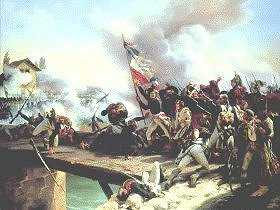 Battalions of National Guard volunteers were formed in three successive levies between 1791 and 1793.
The first battalions were raised in response to King's flight.
In 1791 the National Assembly called upon the departments to raise battalions to maintain internal
order and defend the frontiers from expected invasion. "Two structural differences - the organization of the
battalions along territorial lines and the designation of their officers by election - distinguished the
volunteers from the regular army and lent their cadres particular characteristics. ... Officials who tried to shuffle
volunteers between the companies could face stiff resistance." (Blaufarb - "The French Army 1750-1820" p 101)
Battalions of National Guard volunteers were formed in three successive levies between 1791 and 1793.
The first battalions were raised in response to King's flight.
In 1791 the National Assembly called upon the departments to raise battalions to maintain internal
order and defend the frontiers from expected invasion. "Two structural differences - the organization of the
battalions along territorial lines and the designation of their officers by election - distinguished the
volunteers from the regular army and lent their cadres particular characteristics. ... Officials who tried to shuffle
volunteers between the companies could face stiff resistance." (Blaufarb - "The French Army 1750-1820" p 101)
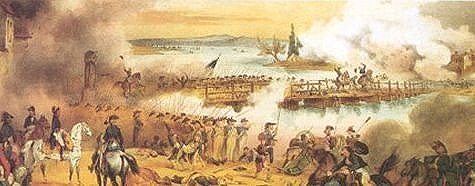 "It had been obvious for some time that firm action was needed to give the army
a cost-efficient and militarily sound organization. Sonsequently, as its last act, the Thermidorean Committee of Public Safety approved a drastic
consolidation of under-strength units and a corresponding reduction of officer strength. ...
The 952 existing battalions were to be consolidated into 140 new demi-brigades of 3 battalions each.
As a result 532 battalions were to be dissolved ... A similar consolidation of the cavalry was to eliminate 145 squadrons, reducing their number from 323 to 178.
... The impact on the officer corps was profound. ... The climate of professional insecurity created by the second amalgame would dominate the mentality of the officer corps for the
duration of the Republic." (Blaufarb - "The French Army 1750-1820" pp 142-3)
"It had been obvious for some time that firm action was needed to give the army
a cost-efficient and militarily sound organization. Sonsequently, as its last act, the Thermidorean Committee of Public Safety approved a drastic
consolidation of under-strength units and a corresponding reduction of officer strength. ...
The 952 existing battalions were to be consolidated into 140 new demi-brigades of 3 battalions each.
As a result 532 battalions were to be dissolved ... A similar consolidation of the cavalry was to eliminate 145 squadrons, reducing their number from 323 to 178.
... The impact on the officer corps was profound. ... The climate of professional insecurity created by the second amalgame would dominate the mentality of the officer corps for the
duration of the Republic." (Blaufarb - "The French Army 1750-1820" pp 142-3)
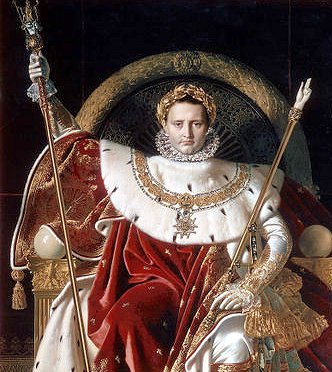

 On picture: charging Napoleonic hussar. Maughan - "Napoleon's Cavalry Recreated in Color Photographs".
On picture: charging Napoleonic hussar. Maughan - "Napoleon's Cavalry Recreated in Color Photographs".
 On picture: Grand parade at Boulogne Camp.
On picture: Grand parade at Boulogne Camp.
 On picture: French light cavalrymen captured British infantryman, by Woodville.
On picture: French light cavalrymen captured British infantryman, by Woodville.
 The problem worsened as the Peninsula became a secondary front. A typical Peninsula regiment of 2,500 men
would send 120 to 200 men back to France as a depot unit, 50 to the artillery, 10 to the gendarmes, and 12
of the best men to the Imperial Guard. These subtractions, coupled with the unprecedented guerilla-inflicted losses
experienced in the never secure rear areas, seriously eroded the staying power of the infantry regiment. It got worse
in 1811 and thereafter when Napoleon withdrew the best troops from the Peninsula to prepare for the Russian invasion."
(James Arnold - "A Reappraisal of Column Versus Line in the Peninsular War")
The problem worsened as the Peninsula became a secondary front. A typical Peninsula regiment of 2,500 men
would send 120 to 200 men back to France as a depot unit, 50 to the artillery, 10 to the gendarmes, and 12
of the best men to the Imperial Guard. These subtractions, coupled with the unprecedented guerilla-inflicted losses
experienced in the never secure rear areas, seriously eroded the staying power of the infantry regiment. It got worse
in 1811 and thereafter when Napoleon withdrew the best troops from the Peninsula to prepare for the Russian invasion."
(James Arnold - "A Reappraisal of Column Versus Line in the Peninsular War")
 In 1811, except the guerilla war in Spain, Europe was in peace.
Napoleon had time to train the young soldiers. They were clothed and well armed.
The cavalry was supplied with thousands of German, Polish and French horses.
The artillery and engineers were well equipped and trained. The Grand Army of
1812 was almost as good as the Grand Army of 1805. But in 1812 there were less veterans
in the ranks but the troops were better suplied and armed (far more guns).
"The veteran troops were sadly diluted by the influx of recent recruits and the demands of the Spanish campaign.
A similar expansion had occurred in 1809 when the French army was largely composed of new recruits. In both instances the recruits lacked the discipline and savoir faire to
be able to sustain themselves in a foraging situation, but as the 1809 campaign was fought in Austria, the impact of this indiscipline on supplies was minimal compared to what it was to be in 1812."
(Nafziger - "Napoleon's Invasion of Russia" p 88)
In 1811, except the guerilla war in Spain, Europe was in peace.
Napoleon had time to train the young soldiers. They were clothed and well armed.
The cavalry was supplied with thousands of German, Polish and French horses.
The artillery and engineers were well equipped and trained. The Grand Army of
1812 was almost as good as the Grand Army of 1805. But in 1812 there were less veterans
in the ranks but the troops were better suplied and armed (far more guns).
"The veteran troops were sadly diluted by the influx of recent recruits and the demands of the Spanish campaign.
A similar expansion had occurred in 1809 when the French army was largely composed of new recruits. In both instances the recruits lacked the discipline and savoir faire to
be able to sustain themselves in a foraging situation, but as the 1809 campaign was fought in Austria, the impact of this indiscipline on supplies was minimal compared to what it was to be in 1812."
(Nafziger - "Napoleon's Invasion of Russia" p 88)
 On picture: Napoleon, his staff and army, from movie 'War and Peace' by Bondarchuk
On picture: Napoleon, his staff and army, from movie 'War and Peace' by Bondarchuk
 "A decree ordering a levy of 300,000 soldiers was made, and another augmenting the Guard to 112,500 men... The levy, however, was not successful. France was exhausted not only of her men, but even of her youth, and boys were now in his greatest need to form his battalions. To add to his trouble, as fortune always seems to delight in pushing down a falling favorite, the Typhus fever broke out among his troops along the Rhine." (Headley - "The Imperial Guard of Napoleon")
"A decree ordering a levy of 300,000 soldiers was made, and another augmenting the Guard to 112,500 men... The levy, however, was not successful. France was exhausted not only of her men, but even of her youth, and boys were now in his greatest need to form his battalions. To add to his trouble, as fortune always seems to delight in pushing down a falling favorite, the Typhus fever broke out among his troops along the Rhine." (Headley - "The Imperial Guard of Napoleon")
 Some of the English authors claim that the French army of 1815 was made up of veterans and was Napoleon's best. The fact is the majority of the army that Napoleon rebuilt after returning from Elba, was composed of soldiers who had at least one campaign behind them, although in the eyes of veterans of Austerlitz and Egypt, the recruits of 1814 still seemed like little boys. (Barbero - "The Battle" p 20) A call for volunteers produced only some laughable 15,000 men.
There were French eyewitnesses who stated that many regiments included a high percentage of young soldiers who had never been under fire. Several battalions of Young Guard were in Vendee. General Lamarque complained that they were filled with recruits and deserters who neither knew how to maneuver nor shoot. (Lasserre - "Les Cent jours en Vendée: le général Lamarque et l'insurrection royaliste, d'après les papiers inédits du général Lamarque." published in 1906.)
Some of the English authors claim that the French army of 1815 was made up of veterans and was Napoleon's best. The fact is the majority of the army that Napoleon rebuilt after returning from Elba, was composed of soldiers who had at least one campaign behind them, although in the eyes of veterans of Austerlitz and Egypt, the recruits of 1814 still seemed like little boys. (Barbero - "The Battle" p 20) A call for volunteers produced only some laughable 15,000 men.
There were French eyewitnesses who stated that many regiments included a high percentage of young soldiers who had never been under fire. Several battalions of Young Guard were in Vendee. General Lamarque complained that they were filled with recruits and deserters who neither knew how to maneuver nor shoot. (Lasserre - "Les Cent jours en Vendée: le général Lamarque et l'insurrection royaliste, d'après les papiers inédits du général Lamarque." published in 1906.)

 The Battle of Gravelotte-St. Privat, was the largest battle during the Franco-Prussian War.
The combined German forces (188,000 men), under von Moltke the Elder defeated
French Army of the Rhine (113,000 men), commanded by Marshal Bazaine.
While most of the Germans fell under the
The Battle of Gravelotte-St. Privat, was the largest battle during the Franco-Prussian War.
The combined German forces (188,000 men), under von Moltke the Elder defeated
French Army of the Rhine (113,000 men), commanded by Marshal Bazaine.
While most of the Germans fell under the 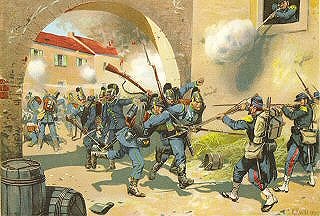 The Battle of Sedan was fought during the Franco-Prussian War in 1870. It resulted in the
capture of
The Battle of Sedan was fought during the Franco-Prussian War in 1870. It resulted in the
capture of